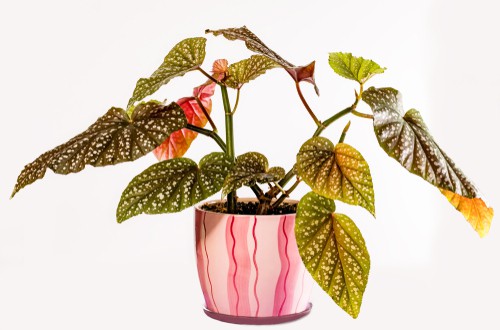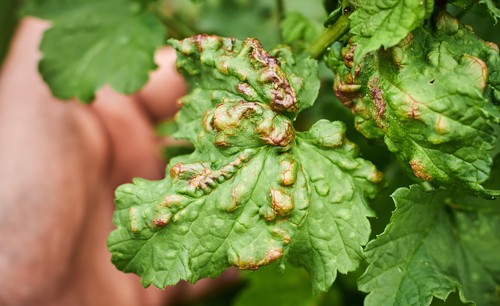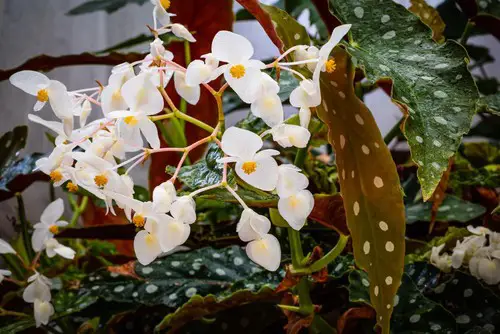Polka dot plants are popular indoor plants that are known for their vibrant foliage and unique patterns. These plants are native to Madagascar and prefer warm, humid conditions. They are relatively easy to care for and can be propagated easily. However, many people wonder if polka dot plants die after flowering.
Polka dot plants are known for their colorful leaves, but they do produce flowers under the right conditions. The flowers are small and not particularly attractive, and they usually appear in the summer.
Once the plant has finished flowering, it will enter a dormant phase. During this time, the plant may lose some of its leaves, but it should not die if it is cared for properly.
If you want to keep your polka dot plant healthy and thriving, it is important to understand its growing conditions and care requirements. With the right care, your polka dot plant can live for several years and continue to produce beautiful foliage. Keep reading to learn more about polka dot plants and how to care for them.
Key Takeaways on Do Polka Dot Plants Die After Flowering?
- Polka dot plants can produce flowers, but they are not particularly attractive and the plant usually enters a dormant phase after flowering.
- With proper care, polka dot plants can live for several years and continue to produce vibrant foliage.
- Understanding the growing conditions and care requirements of polka dot plants is essential for keeping them healthy and thriving.
Learn more about plant care from these other posts:
- Water or Soil? Comparing The Best Medium for Optimal Plant Size and Health
- Deciphering the Optimal Growth Time for Plants – Day or Night?
- Do Monstera Plants Thrive in Root Bound Conditions?
Understanding Polka Dot Plants

Polka dot plants, also known as Hypoestes phyllostachya, are a popular indoor plant with spotted leaves that add a splash of color to any room. These plants are native to Madagascar and are known for their green foliage flecked with pink, white, purple, and other colors.
Polka dot plants are relatively easy to care for and can thrive in a variety of indoor environments. They prefer bright, indirect light and well-draining soil that is kept consistently moist. However, it is important not to overwater them, as this can lead to root rot and other problems.
One common question people have about polka dot plants is whether they die after flowering. While polka dot plants do produce flowers as part of their natural life cycle, flowering does not necessarily mean the plant will die. In fact, many polka dot plants can continue to grow and thrive even after flowering.
However, it is important to note that some polka dot plants may experience a decline in health after flowering. This can be due to a variety of factors, such as age, environmental conditions, or disease. If you notice your polka dot plant starting to wilt or lose its vibrant colors after flowering, it may be a sign that something is wrong.
To keep your polka dot plant healthy and thriving, it is important to provide it with the right care and attention. This may include regular pruning, fertilization, and pest control measures. By taking good care of your polka dot plant, you can help ensure that it continues to thrive and add beauty to your indoor space.
Growing Conditions for Polka Dot Plants
1. Lighting Requirements
Polka dot plants prefer bright, indirect light. Direct sunlight can scorch their leaves, while too little light can cause the leaves to lose their vibrant colors. If the plant is not getting enough light, the leaves may become dull and yellow. If it is getting too much light, the leaves may bleach and turn brown.
2. Temperature and Humidity
Polka dot plants thrive in warm temperatures between 60-80°F (15-27°C). They also prefer a humid environment, which can be achieved by misting the leaves regularly or placing a humidifier nearby. In dry climates, it may be necessary to increase humidity levels by placing a tray of water near the plant.
3. Soil Requirements

Polka dot plants require moist soil with good drainage. The soil should be kept consistently moist, but not waterlogged. Overwatering can lead to root rot and other problems. The soil should also have good drainage, so it is essential to use a pot with drainage holes and a growing medium that includes perlite or pumice to improve drainage.
It is best to use a well-draining commercial potting mix that is rich in organic matter. The pH level of the soil should be slightly acidic, between 5.5 and 6.5. It is also important to avoid compacting the soil around the roots, which can impede drainage and cause root rot.
Polka dot plants are relatively easy to care for, provided their basic growing requirements are met. With proper lighting, temperature, humidity, and soil conditions, they can thrive and produce vibrant, colorful leaves.
Caring for Polka Dot Plants
Polka dot plants are relatively easy to care for, but they do require some attention to thrive. Proper watering, feeding, pruning, and repotting practices are essential to keep these plants healthy.
1. Watering Practices
Polka dot plants prefer consistently moist soil, but they can be prone to root rot if overwatered. It is important to water these plants thoroughly, allowing excess water to drain out of the bottom of the pot. It is also essential to avoid letting the soil dry out completely between waterings.
To prevent overwatering, it is recommended to check the soil moisture level regularly. Stick your finger about an inch into the soil; if it feels dry, it is time to water. If the soil feels moist, wait a few more days before watering again.
2. Feeding and Fertilization
Polka dot plants benefit from regular feeding with a balanced organic fertilizer. It is recommended to fertilize these plants every two weeks during the growing season (spring and summer) and reduce the frequency to once a month during the dormant season (fall and winter).
When applying fertilizer, it is important to follow the manufacturer’s instructions and avoid over-fertilizing, as this can lead to salt buildup in the soil and damage the plant.
3. Pruning and Repotting

Pruning is essential to keep polka dot plants bushy and full. Pinching off any stems that get too long or flowers as they begin to develop will help keep the plant healthy.
Repotting is recommended every one to two years, as polka dot plants can become root-bound. When repotting, it is important to choose a pot that is slightly larger than the current one and use well-draining soil.
Polka Dot Plant Flowering
The Polka Dot Plant is known for its freckled leaves, but it can also surprise its growers with delicate purple or blue blossom spikes. In this section, we will discuss the bloom cycle of the Polka Dot Plant and how to care for it after flowering.
Bloom Cycle
The Polka Dot Plant blooms in the summer, producing lilac flowers on spikes that are not showy. These flower spikes can be removed, so they don’t drain energy from foliage development. The bloom cycle of the Polka Dot Plant is an important part of its life cycle, and it is essential to understand it to maintain the plant’s health.
After Flowering Care
After the Polka Dot Plant has finished blooming, it is important to care for it properly to ensure its continued health. The first step is to remove the spent flower spikes, which will help the plant conserve its energy. It is also important to continue providing the plant with the proper amount of water and nutrients.
If the plant is grown in a container, it may need to be repotted after flowering to ensure that it has enough space to grow. The new pot should be slightly larger than the old one, and the soil should be rich and well-draining. It is also important to keep the plant in a location that receives bright, indirect sunlight
Potential Problems with Polka Dot Plants
Polka dot plants are generally easy to care for and maintain, but they can still suffer from a variety of issues that can cause them to wilt, yellow, or even die. In this section, we will explore some of the common problems that polka dot plants may face.
Common Diseases

Polka dot plants are susceptible to various plant diseases, and it’s essential to identify and treat them promptly to prevent further damage. One of the most common diseases that polka dot plants can suffer from is powdery mildew.
Powdery mildew appears as a white or gray powdery substance on the leaves, stems, and flowers of the plant. This disease thrives in humid environments and can be prevented by ensuring adequate air circulation around the plant.
Another disease that can affect polka dot plants is root rot. Root rot occurs when the roots of the plant are exposed to too much water, causing them to rot. This can lead to wilting, yellowing, and drooping leaves.
To prevent root rot, make sure the plant is not overwatered and that the soil has adequate drainage. If root rot has already set in, it may be necessary to repot the plant and treat the remaining roots with fungicide.
Pest Infestation
Polka dot plants can also suffer from pest infestations, which can cause wilting, yellowing, and crispy leaves. Mealybugs, aphids, and whiteflies are common pests that can infest polka dot plants.
These pests feed on the plant’s sap, causing damage to the leaves and stems. To prevent pest infestations, make sure to keep the plant in proper lighting conditions and avoid overwatering. If pests have already infested the plant, it may be necessary to use insecticidal soap or neem oil to control the infestation.
Propagation of Polka Dot Plants
Polka dot plants can be propagated through seeds or cuttings. Propagation through seeds is a bit more challenging than through cuttings, but it is still a viable option.
The seeds require warm temperatures to germinate, around 70 to 75 degrees F. (21-24 C.), and will do so within about two weeks given adequate conditions. It usually helps to add a clear plastic covering over the tray or pot to hold in both heat and moisture. This should be placed in indirect sunlight.
Propagation through cuttings is a more straightforward process. To begin, select a healthy stem from the mother plant. Cut it at a 45-degree angle just below a node. The cutting should be around 3-4 inches long and have a few leaves attached.
Remove the lower leaves from the cutting, leaving only a few at the top. Dip the cut end of the stem into rooting hormone powder, and then plant it in moist potting soil. Place the pot in a warm, bright location, but not in direct sunlight. Keep the soil moist but not waterlogged. Within a few weeks, the cutting should begin to root and produce new growth.
Propagation through cuttings is the preferred method for most gardeners because it is faster and more reliable than seed propagation. However, it is essential to note that polka dot plants can be sensitive to changes in their environment, so it is crucial to provide them with consistent care during the propagation process.
Indoor Vs Outdoor Polka Dot Plants\

Polka dot plants can be grown both indoors and outdoors. The lifespan of a polka dot plant differs depending on whether it is grown indoors or outdoors.
Indoor Polka Dot Plants
Indoor polka dot plants are typically treated as annuals, lasting only a year or two. They require bright, indirect light and a well-draining soil mix. Overwatering can lead to root rot, which is a common cause of death for indoor polka dot plants. Indoor polka dot plants can also be susceptible to pests such as spider mites and mealybugs.
Outdoor Polka Dot Plants
Outdoor polka dot plants are perennials and can live for a long time if planted in the garden. They require well-draining soil and can tolerate full sun to partial shade.
Outdoor polka dot plants can also be susceptible to pests and diseases such as powdery mildew and leaf spot. However, they are less likely to be affected by these issues than indoor polka dot plants.
Conclusion
The lifespan of polka dot plants is relatively short, and they typically die after flowering. However, this does not mean that they are difficult to grow or maintain. With proper care and attention, polka dot plants can thrive and produce beautiful foliage for an extended period.
Polka dot plants are relatively easy to grow, and they do well in bright, indirect light. They prefer moist, well-draining soil and should be watered regularly to prevent wilting. Overwatering can lead to root rot, which is a common cause of polka dot plant death.
Temperature changes can also impact the lifespan of polka dot plants. They prefer temperatures between 60 and 75 degrees Fahrenheit and should be kept away from drafts and extreme temperature fluctuations.
While polka dot plants do spend a significant amount of energy producing flowers and seeds, this is not the only reason for their short lifespan. Lack of proper care and attention can also contribute to their premature death.
Frequently Asked Questions
Do polka dot plants come back every year?
Polka dot plants are typically grown as annuals, meaning they complete their life cycle in one growing season. However, it is possible to keep them alive for multiple years by overwintering them indoors.
How long do polka dot plants live indoors?
With proper care, polka dot plants can live for several years indoors. However, their lifespan may be shorter if they are not given the right growing conditions or if they are affected by pests or diseases.
Polka dot plant crispy leaves?
Crispy leaves on a polka dot plant can be a sign of underwatering or exposure to direct sunlight. To prevent this, make sure the plant is watered regularly and placed in a location with bright, indirect light.
How to propagate polka dot plant?
Polka dot plants can be propagated through stem cuttings. Simply take a cutting from a healthy plant and place it in a pot with moist soil. Keep the soil moist and the cutting should root within a few weeks.
How big do polka dot plants get?
Polka dot plants can grow up to 12 inches tall and 12 inches wide. However, their size can be controlled through pruning.
What is the lifespan of a polka dot Hypoestes?
The lifespan of a polka dot Hypoestes can vary depending on the growing conditions and care provided. With proper care, they can live for several years. However, they are typically grown as annuals and complete their life cycle in one growing season.

Hey, I’m Lisa and I’ve been an avid gardener for over 30 years. I love writing, talking and living in the garden! Feel free to connect with me on my socials below


